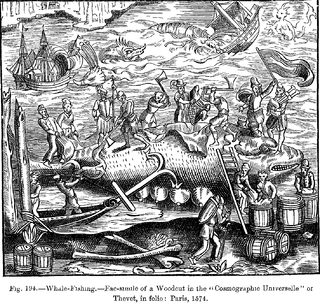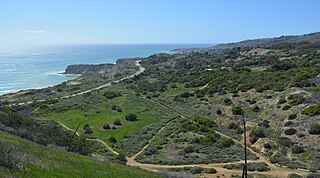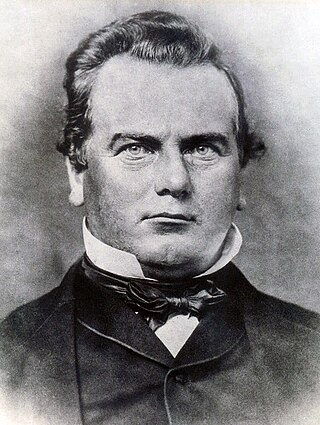
The gray whale, also known as the grey whale, gray back whale, Pacific gray whale, Korean gray whale, or California gray whale, is a baleen whale that migrates between feeding and breeding grounds yearly. It reaches a length of 14.9 meters (49 ft), a weight of up to 41 tonnes (90,000 lb) and lives between 55 and 70 years, although one female was estimated to be 75–80 years of age. The common name of the whale comes from the gray patches and white mottling on its dark skin. Gray whales were once called devil fish because of their fighting behavior when hunted. The gray whale is the sole living species in the genus Eschrichtius. It is the sole living genus in the family Eschrichtiidae, however some recent studies classify it as a member of the family Balaenopteridae. This mammal is descended from filter-feeding whales that appeared during the Neogene.

This article discusses the history of whaling from prehistoric times up to the commencement of the International Whaling Commission (IWC) moratorium on commercial whaling in 1986. Whaling has been an important subsistence and economic activity in multiple regions throughout human history. Commercial whaling dramatically reduced in importance during the 19th century due to the development of alternatives to whale oil for lighting, and the collapse in whale populations. Nevertheless, some nations continue to hunt whales even today.

The Portuguese Bend region is the largest area of natural vegetation remaining on the Palos Verdes Peninsula, in Los Angeles County, California. Though once slated for development including the projected route of Crenshaw Boulevard, the area is geologically unstable and is unsuitable for building.

Phineas Banning was an American businessman, financier and entrepreneur.
Magdalena Bay is a 50 km (31 mi) long bay in Comondú Municipality along the western coast of the Mexican state of Baja California Sur. It is protected from the Pacific Ocean by the unpopulated sandy barrier islands of Isla Magdalena and Isla Santa Margarita.

San Ignacio Lagoon is a lagoon located in Mulegé Municipality of the Mexican state of Baja California Sur, 59 kilometers from San Ignacio, Mexico, and Highway 1. It is one of the winter sanctuaries of the eastern Pacific gray whale.
Founded in 1967, the American Cetacean Society (ACS) was the first whale conservation group in the world. ACS is a 501(c)(3) non-profit organization with an office in San Pedro, California and chapters in Los Angeles, Orange County, Puget Sound (Seattle), Monterey, San Francisco, and a Student Coalition based out of Indiana University. The mission of the American Cetacean Society is to protect whales, dolphins, porpoises, and their habitats through public education, research grants, and conservation actions. ACS's programs are almost entirely conducted by volunteers.

Commercial whaling in the United States dates to the 17th century in New England. The industry peaked in 1846–1852, and New Bedford, Massachusetts, sent out its last whaler, the John R. Mantra, in 1927. The Whaling industry was engaged with the production of three different raw materials: whale oil, spermaceti oil, and whalebone. Whale oil was the result of "trying-out" whale blubber by heating in water. It was a primary lubricant for machinery, whose expansion through the Industrial Revolution depended upon before the development of petroleum-based lubricants in the second half of the 19th century. Once the prized blubber and spermaceti had been extracted from the whale, the remaining majority of the carcass was discarded.
Samuel Enderby & Sons was a whaling and sealing company based in London, England, founded circa 1775 by Samuel Enderby (1717–1797). The company was significant in the history of whaling in the United Kingdom, not least for encouraging their captains to combine exploration with their business activities, and sponsored several of the earliest expeditions to the subantarctic, Southern Ocean and Antarctica itself.
Charles Enderby (1797–1876) was one of three sons of Samuel Enderby Junior (1756–1829). He was the grandson of Samuel Enderby (1717–1797), who founded the Samuel Enderby & Sons company in 1775. Samuel Enderby & Sons was one of the most prominent English sealing and whaling firms, active in both the Arctic and Southern Oceans. Charles and his two brothers, Henry and George, inherited Samuel Enderby & Sons when their father Samuel Junior died in 1829. They moved the company headquarters in 1830 from Paul's Wharf to Great St. Helens in London.

Eber Bunker (1761–1836) was a sea captain and pastoralist, and he was born on 7 March 1761 at Plymouth, Massachusetts. He commanded one of the first vessels to go whaling and sealing off the coast of Australia. His parents were James Bunker and his wife Hannah, née Shurtleff.

Whale conservation refers to the conservation of whales.

Charles Melville Scammon (1825–1911) was a 19th-century whaleman, naturalist, and author. He was the first to hunt the gray whales of both Laguna Ojo de Liebre and San Ignacio Lagoon, the former also known as "Scammon's Lagoon" after him. In 1874 he wrote the book The Marine Mammals of the North-western Coast of North America, which was a financial failure. It is now considered a classic.
The Basques were among the first people to catch whales commercially rather than purely for subsistence and dominated the trade for five centuries, spreading to the far corners of the North Atlantic and even reaching the South Atlantic. The French explorer Samuel de Champlain, when writing about Basque whaling in Terranova, described them as "the cleverest men at this fishing". By the early 17th century, other nations entered the trade in earnest, seeking the Basques as tutors, "for [they] were then the only people who understand whaling", lamented the English explorer Jonas Poole.

Medvezhy Island is a long, narrow island in the northwestern Sea of Okhotsk, the westernmost of the Shantar Islands. It lies on the eastern side of Uda Gulf. It is 12.9 km long. It is separated from the mainland by Shevchenko Straight.
Lebyazhya Bay is a small bay that indents the south side of Feklistova Island, one of the Shantar Islands, in the western Sea of Okhotsk. Its entrance is 11.3 kilometers (7.0 mi) wide and it is 5.6 kilometers (3.5 mi) deep. There are three small bays at its head: Enegelma Road to the west, Soboleva to the north, and Rosseta to the east. A small island, Sukhotina, lies to its southeast. In the spring and summer it is host to a small nesting colony of thick-billed murre. A number of streams of fresh water flow down the hills into the bay. Spring tides rise 6.5 meters (21 ft) while neaps rise 2.4 meters.

Commercial whaling in Britain began late in the 16th century and continued after the 1801 formation of the United Kingdom and intermittently until the middle of the 20th century.
Thomas W. Long was an American whaling ship master.
Glinyanyy Island is a small island on the east side of Gizhigin Bay, in the northeastern Sea of Okhotsk. It is cone shaped.
Pusey Hall was launched at Lancaster in 1808 as a West Indiaman. Between 1830 and 1837 she made two voyages as a whaler in the British southern whale fishery. She returned to trade and was wrecked at Patagonia in 1846 while engaged in the guano trade.











